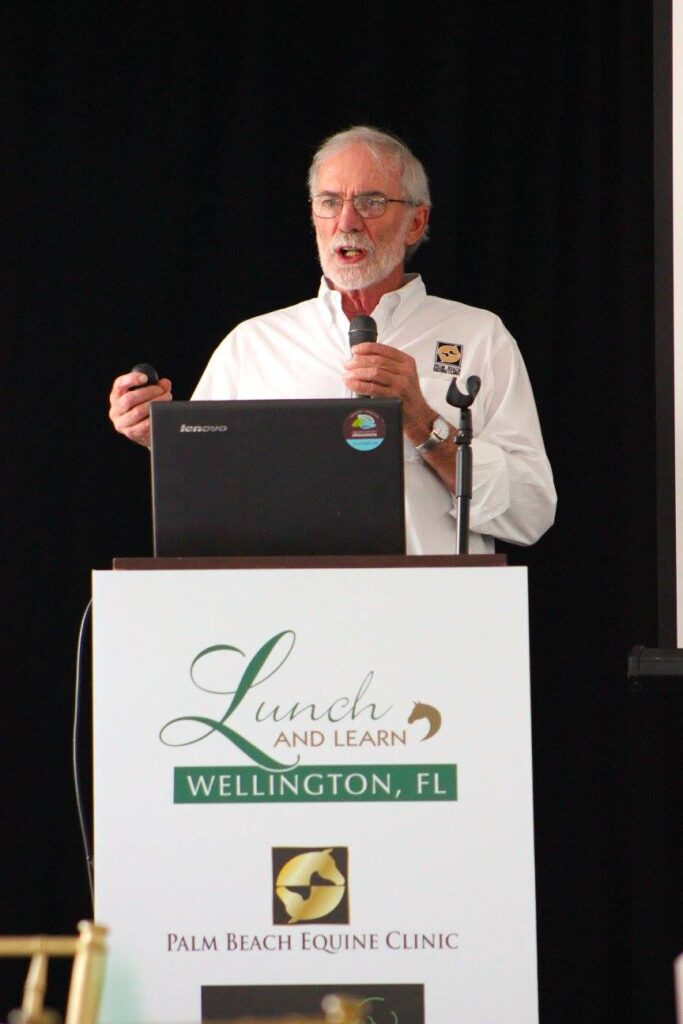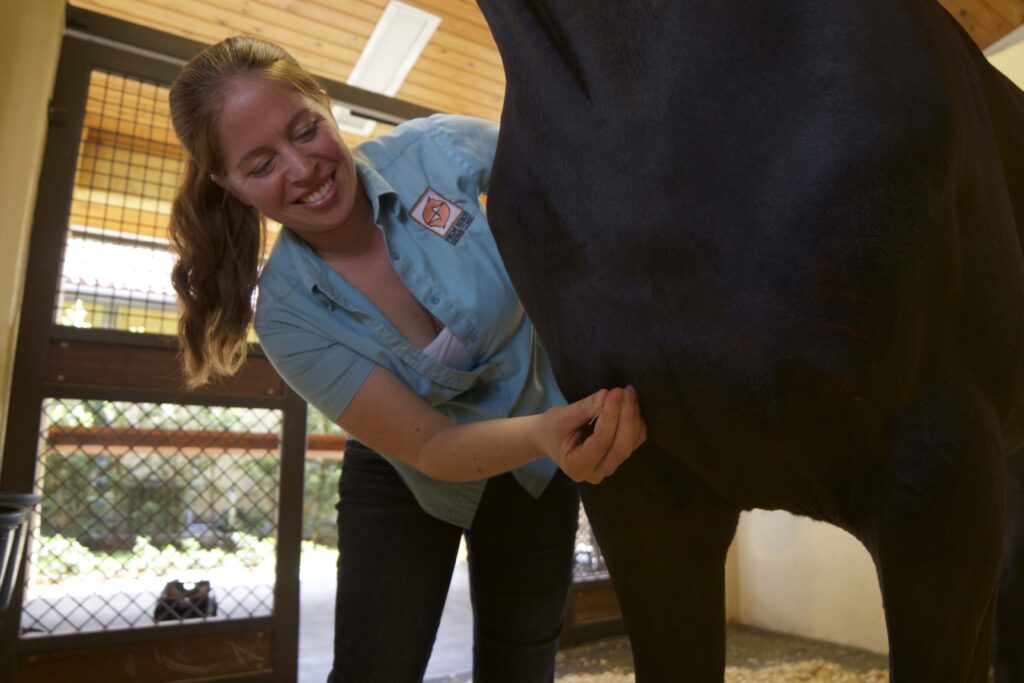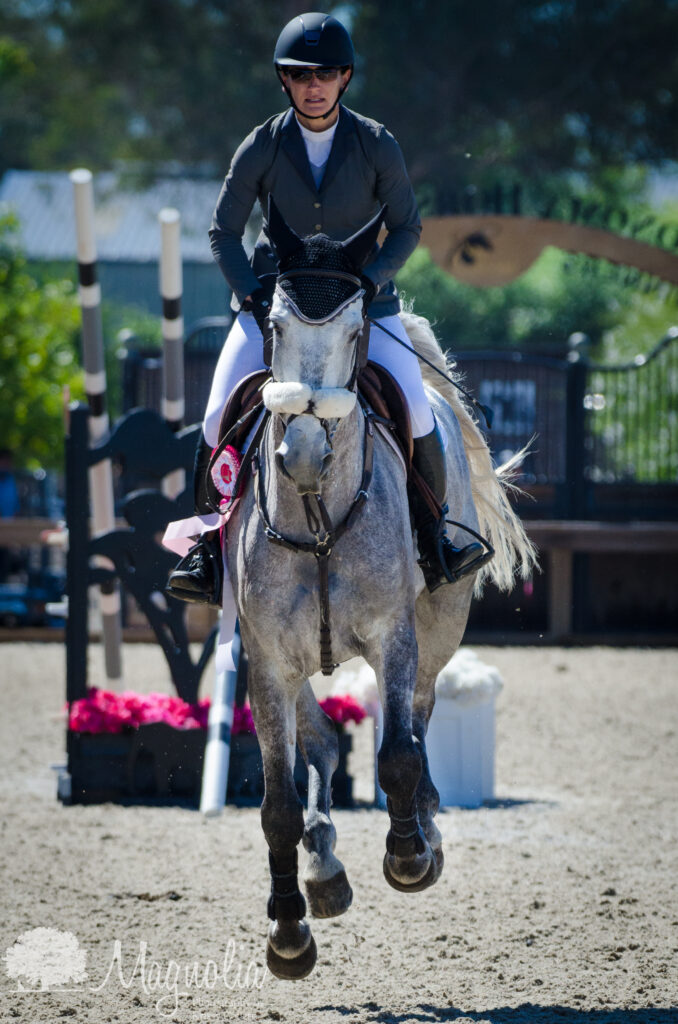Month: September 2016

Thrush, rainrot, and scratches are problems that most equestrians have probably encountered, but in the hot, wet climate of South Florida, these issues can incessantly plague horses and their owners. While different in their presentation, thrush, rainrot, and scratches have a lot in common. For horse owners, there are several problems that arise due to environmental factors or predisposing conditions, but these issues can easily be prevented or treated with proper care and management.
This month, Palm Beach Equine Clinic’s Dr. Bryan Dubynsky shared his expertise on the causes, treatment, and prevention of thrush, rainrot, and scratches.
What is Equine Thrush?
Thrush is an infection within the horse’s hoof, most commonly caused by bacteria that invade the deeps clefts or grooves (known as sulci) of the frog. Fusobacterium Necrophorum is the common bacterial culprit, which naturally occurs in the environment, especially in wet, muddy, or unsanitary areas. Thrush bacteria thrives where there is a lack of oxygen.
Causes of Equine Thrush
Some horses are predisposed to developing thrush due to conformation, such as a rather high heel or deep sulci, or a narrow or contracted heel. The bacteria will manifest in horse’s feet that are not picked out regularly, or standing in muddy, wet environments, including paddocks or stalls that have not been cleaned properly.
Thrush can typically be first identified by the odor. The frog will have a strong, rotten odor and become spongy. Visually, the frog can even exudate (oozing) pus.
Treating Equine Thrush
The treatment for Thrush is fairly simple as it is very sensitive to oxygen. The most important thing is to have your vet or farrier trim or debride the frog to expose areas to the air. It is best to keep the hoof clean and dry. Adding a common detergent to the Thrush areas, such as Betadine or any commercial product (Thrush Buster, Coppertox, etc.) will help to kill the bacteria. Most importantly, if the horse is not removed from those predisposing environmental factors, treatments can be ineffective.
Maintaining a level of activity for our equine partners will increase blood flow to the feet and promote health to the area. Horses found in dry environments with ample space to move typically do not suffer from Thrush. The activity of horses moving keeps the frogs healthier. The more blood flow you have in the foot, the less chance that infection is able to manifest.
Thrush is not guaranteed to cause lameness. In extreme rare cases, Thrush can penetrate deeper and cause an infection in deeper tissue or even in the coffin bone. When in doubt, always contact your veterinarian.
What is Equine Rainrot (Dermotophilus Congolensis)?
Rainrot is caused by a naturally occurring bacteria named Dermotophilus, which produces spores. rainrot is recognized as scabby, scaly, crusty spots on areas of the horse that have been exposed to rain. It is commonly seen on the neck or across the back (dorsum). rainrot is not typically apparent on the legs or under the belly.
Causes of Rainrot

When there is a break in the skin, which can be even as simple as an insect bite, a surplus of rain on the skin washes away the natural protective oils. Once the skin is stripped of the natural protective layer or any sort of trauma to the skin barrier occurs, those spores are able to invade the deeper dermis skin layers. The spores penetrate into the deeper layers of the dermis, and the body reacts by sending white blood cells and proteins to fight the invaders. This reactive response causes the small pustules, scabs, and bumps to form.
Similar to thrush, rainrot is an environmental issue. It is most commonly seen in warm areas with high humidity, excess rain, and insects. The most important prevention is to keep horses out of the rain for prolonged periods of time. A horse can be out in the rain for short periods of a day or two, but if it is constantly in hot and rainy conditions with biting insects, more than likely the horse will develop rainrot.
Treating Equine Rainrot
Dr. Dubynsky emphasizes that topical products are not worth anything if the horse is not removed from the environmental factors. Once you remove the environmental factors, a keratolytic agent (something that exfoliates keratin), such as Benzoyl Peroxide or an antibacterial shampoo will help the skin heal. He also cautions that if the horse does have scabs, you do not necessarily want to pick the scabs off because then you are just leaving open skin without protection for more bacteria to invade. The most important tip to healing is to keep the area dry.
In very rare, severe cases of rainrot, it is best to contact your veterinarian to put the horse on antibiotics. If left untreated, and the horse is not removed from the environmental causative factors, the infestation can lead to Staphylococcal Folliculitis; a type of Staph bacteria that will invade the hair follicles and cause a more serious situation.
What are Equine Scratches?
Scratches is a generic term for many different ailments. The definition of scratches can be a bacterial, fungal, or viral dermatitis or inflammatory condition of the pastern or fetlock. It is defined as a chronic Seborrheic Dermatitis (flaking of the skin), characterized by hypertrophy (enlargement of tissue from an increase in cells) and exudation (escape of liquid from blood vessels through pores or breaks in the cell membranes) on the rear (palmar plantar) surface of the pastern and fetlock.
Causes of Equine Scratches
There are certainly predisposing factors for Scratches, including the same environmental factors that cause Thrush or Rainrot. Predisposing factors for Scratches include horses that are bathed often or stand in wet conditions all the time. Horses that have an excess amount of hair on their legs, especially draft horses, also develop scratches easily because the hair traps dirt and moisture on the skin.
Scratches can develop in horses that are bathed too often such as the intensely managed show horse. The show horse is desired to be very clean, which can mean several baths a day. This will strip away the natural protective oils and barrier of the dermis, which allows bacteria or fungi to invade. When moisture penetrates the skin, it causes inflammation reacting with heat, redness, pain, and loss of protection to keep bacteria out.
Prevention and Treatment of Equine Scratches
The most effective first step for prevention and treatment should be to remove the environmental predisposing factors. Removing excess hair during the humid months and keeping horses clean and dry to the best of your ability will reduce the probability of developing an infection. Bathing horses once a day with Betadine or antifungal/antibacterial shampoo will help to clear the infection. Be sure to leave the shampoo on for 20 minutes for all of the medicine to penetrate, rinse thoroughly, and make sure the horse is completely dry. In order to effectively treat the bacteria, horses should be completely towel or air dried before returning to their stalls or paddocks.
As always, contact your veterinarian immediately if there appears to be deeper infection present, or you would like more detailed information on how to treat and prevent these bacterial infections. For more information, contact Palm Beach Equine Clinic at 561-793-1599.
The 2016 Olympic Games in Rio de Janeiro, Brazil is finally here and Palm Beach Equine Clinic is proud to have its own Dr. Jorge Gomez present to provide veterinary support for some of the world’s most elite horses. Dr. Gomez is not only a top sport horse practitioner, but is also a renowned Board-Certified Surgeon.

Dr. Gomez will be in attendance at the prestigious Games to serve as the veterinarian for the team horses in show jumping events representing Venezuela and Colombia held August 14-18. Two elite horse and rider combinations competing for individual medals will represent each country. On behalf of Colombia, Daniel Bluman with Apardi and Rene Lopez aboard Con Dios III will compete individually. The riders representing Venezuela competing for individual medals include Pablo Barrios riding Antares and Emanuel Andrade with Hardrock Z.
Olympic Veterinary Responsibilities
There is a tremendous amount of work that is required in preparing and maintaining a top performance horse for a significant world championship event such as the Olympic Games. While in Rio, Dr. Gomez will closely monitor that each horse is in optimal health conditions while competing. He is responsible for providing and administering permitted medications for muscle, joint, and tendon support, as well as vitamins and intravenous fluids, if necessary. Dr. Gomez also assists the competitors by providing and prescribing physical alternative therapies that help maintain the horse in the best possible form for competition.
There is a tremendous amount of work that is required in preparing and maintaining a top performance horse for a significant world championship event such as the Olympic Games. While in Rio, Dr. Gomez will closely monitor that each horse is in optimal health conditions while competing. He is responsible for providing and administering permitted medications for muscle, joint, and tendon support, as well as vitamins and intravenous fluids, if necessary. Dr. Gomez also assists the competitors by providing and prescribing physical alternative therapies that help maintain the horse in the best possible form for competition.
Dr. Gomez, originally from Colombia, has been affiliated with Palm Beach Equine Clinic since 2011 and has since represented the clinic at the 2012 Olympic Games in London, England, the 2015 Pan American Games in Toronto, Canada, and the 2014 Alltech FEI World Equestrian Games in Normandy, France.
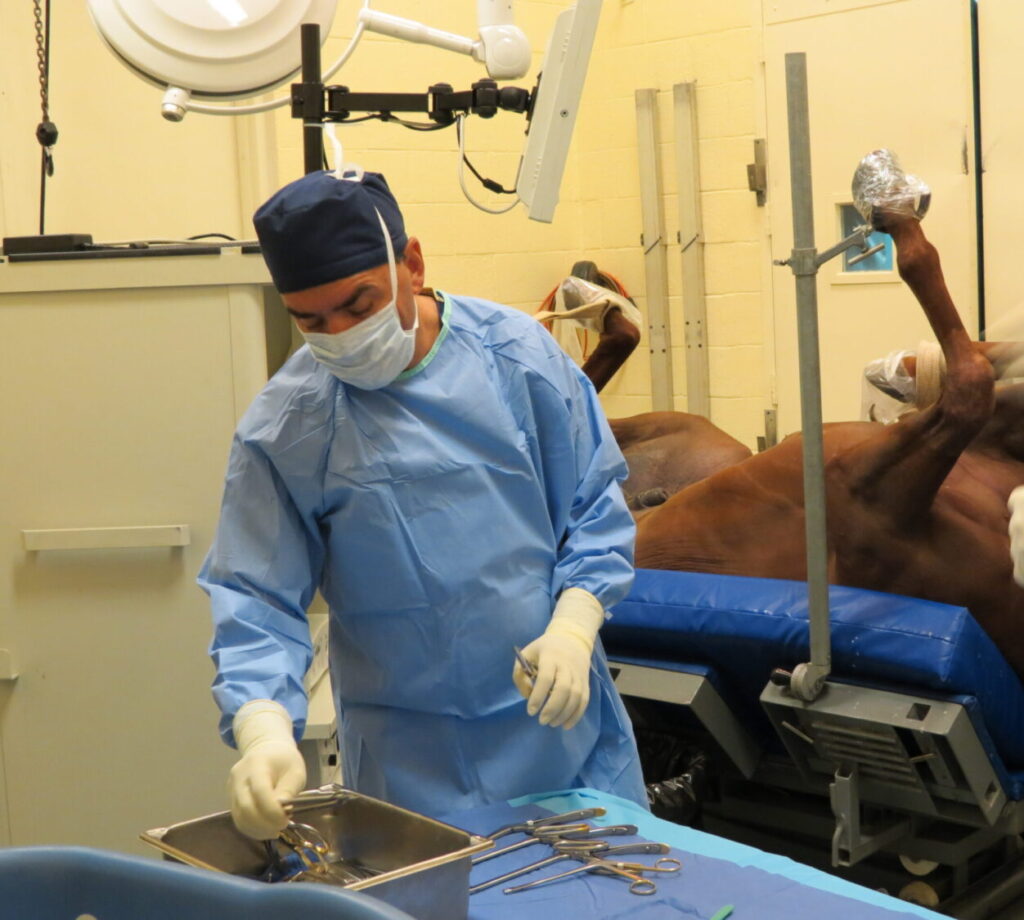
“It is a good opportunity to meet people at all levels and from all over the world that are involved in equestrian sports,” Dr. Gomez said of representing the clinic worldwide. “Palm Beach Equine Clinic becomes a familiar place for all those acquaintances to come to and to refer their horses when they come to Wellington. Many of the horses that we take care of during the Winter Equestrian Festival in Wellington are referred to us because of the connections that we have made at the international competitions.”
Caring for Olympic Equine Athletes
Since he has served at many major international events, Dr. Gomez understands the larger significance of preparing for the Olympic Games. An Olympic medal is a lifelong dream for most grand prix competitors, and having the right horse in peak condition is essential.
“Caring for the horses at the Olympic Games is the same as any other competition, but there are maximal responsibilities,” Dr. Gomez detailed. “Because of the nature of the event, riders want us to be checking the horses entirely on a daily basis for at least one week before the event starts.
“Of the four horses that will be under my care, three of them are my regular clients, so I keep a fairly close eye on them already,” Dr. Gomez added. “In conjunction with trainers and riders, we planned a schedule that we think is the best for the event. I look forward to the competition, and I hope that the horses under my care perform according to expectations.”
Palm Beach Equine Clinic, the industry leader in sport horse veterinary care, features an illustrious list of veterinarians who are experts in their respective fields. Dr. Gomez and PBEC’s team of 30 veterinarians, including Board-Certified Surgeons and Radiologists, are available to provide services to clientele throughout North America and around the world in the various horse sport disciplines
Equine Ophthalmology
Article by Susan M. Carastro, DVM, MS
Diplomate, American College of Veterinary Ophthalmologists
Palm Beach Equine Clinic is proud to have great consulting relationships with many equine medical professionals throughout the country, including Susan M. Carastro, DVM, MS, of the Animal Eye Specialty Clinic. A Diplomate of the American College of Veterinary Ophthalmologists, Dr. Carastro shared her expertise on some of the most common diseases of the equine eye.
Understanding the Equine Eye
Equines have a uniquely developed eye suited to accommodate the lifestyle and needs of our equine companions. The location of the equine eyes being on the side of the head allows for a more panoramic view for protection. This is imperative to the fight or flight response as visual detection of a threat is necessary to alert the flight animals to flee.
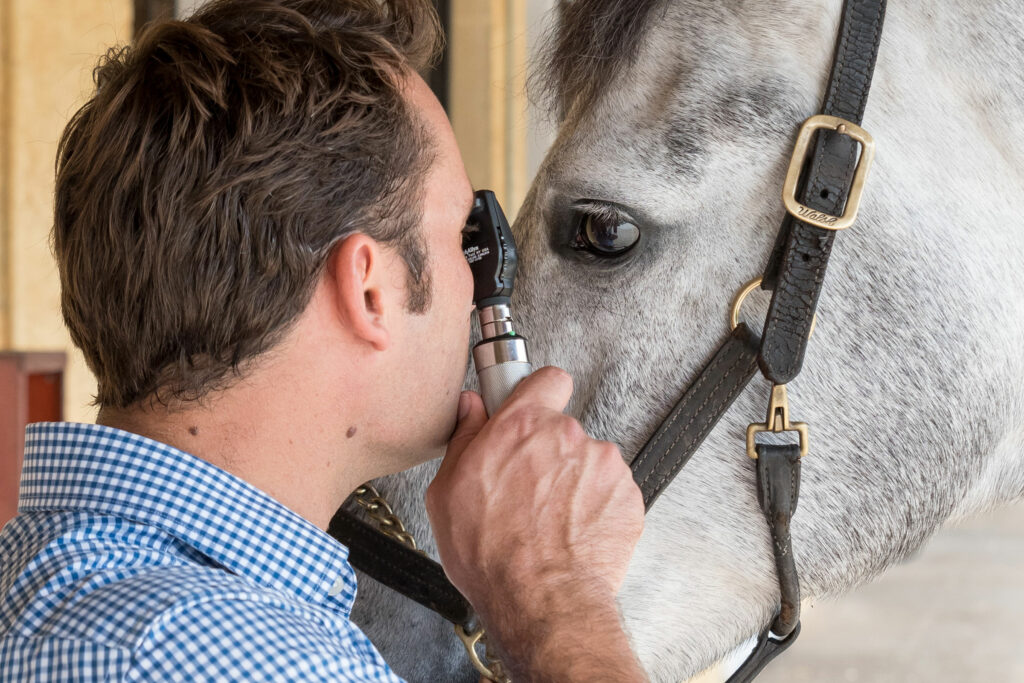
Protecting the Horse’s Eyes
There are a few common diseases of the equine eye that are worth having basic knowledge about. Early recognition and proper treatment is ideal to minimizing damage to the eye. Eyelid cuts or lacerations can occur with contact of numerous objects, but most commonly occur with catching the eyelid on a metal S ring on buckets or nails, or splits in the lid margin from blunt trauma. Eyelid lacerations are easily identified and repaired with primary closure or suturing.
The eyelids have an extensive blood supply and can bleed excessively. As long as the globe is not damaged, the eyelids have an excellent capacity to heal with minimal impact on ocular health. No matter how extensive the laceration appears, every attempt should be made to salvage as much eyelid margin as possible. Allowing the eyelids to heal without suturing can result in poor cosmetic appearance, enhanced scarring, and irregular eyelid margins. The scarring can result in hair or lashes contacting the cornea surface causing chronic irritation or discomfort.
Corneal injuries are one of the most common vision-threatening and painful equine eye diseases. The cornea is the front clear part of the eye that protects the delicate intraocular structures. Ulcers are generally due to abrasion or puncture with environmental objects (hay, branches, and sand). Clinical signs of a corneal ulcer include squinting, tearing, swelling around the eye, redness to the eye, and/or cloudiness to the eye. Corneal ulcers can be confirmed by careful examination of the equine eye and staining with a green dye (fluorescein). Uncomplicated superficial corneal ulcers can heal without leaving any residual damage. Once an ulcer has occurred, the main concern is the risk of corneal infection. Topical therapy with antibiotics, as well as anti-fungal agents four times daily is recommended until the ulcer heals.
Equine Eye Infections and Conditions
Bacterial and/or fungal corneal infections can be devastating and result in loss of vision and the eye. These infections are more common in the southeastern United States with the heat and humidity supporting the growth of these organisms. If a corneal infection occurs, aggressive topical therapy up to every hour and in many cases, surgery, is necessary to save the eye.
Hourly medication can be quite difficult due to personal time constraints, and the horse will keep the eye forcefully closed because of the pain and light sensitivity. A subpalpebral lavage system can be placed for easier and more effective treatment. This is a small tube or catheter inserted through the upper or lower eyelid with the injection port being attached to the mane near the withers. The lavage allows for medication to be injected through the catheter to reach the eye without coming near the horse’s head. Corneal infections in horses can take months to clear. Corneal ulcers can also be extremely painful, thus pain control with atropine and banamine will minimize discomfort and distress.
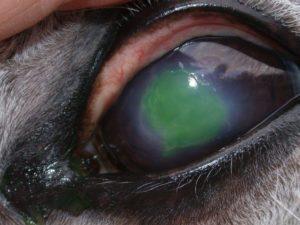
Equine recurrent uveitis or moon blindness affects horses worldwide. Uveitis is an inflammation of the iris (colored part of the eye) that can be caused by numerous issues. These include trauma, infections in other parts of the body, or can be generated by the horse’s own immune system, but there is also a genetic predisposition for Appaloosas and Draft breeds.
Signs and Treatment of Equine Recurrent Uveitis
Clinical symptoms of uveitis include a painful eye (squinting, tearing), cloudiness to the eye, and swelling around the eye. If uveitis is diagnosed, evaluation for infections or inflammations elsewhere in the body should be pursued. This may include bloodwork, titers for specific infections including Leptospirosis, abdominal ultrasound, chest radiographs, and sampling of fluid from inside the equine eye.
If no underlying cause can be identified, the main goal is minimizing inflammation inside of the eye to control pain and limit the impact on vision.
Treatments that are used include topical steroids and nonsteroidal agents, oral steroids and nonsteroidal agents (banamine/bute), and atropine.
Management
The frustrating part of this disease is the recurrent nature. The interval of flare-ups can range between days to years in patients. Management for horses affected with uveitis is to limit the frequency and severity of the episodes with lifelong treatment. This can be accomplished with daily maintenance medication (topical and/or oral) even when there is no active inflammation. If the equine eye is still having flare-ups, surgical implantation of a device impregnated with anti-inflammatory medication called cyclosporine allows for a constant release of drug into the eye to limit episodes.
If the uveitis remains poorly controlled, further consequences including cataracts, glaucoma, and retinal detachment can result in loss of vision and a painful eye requiring removal of the eye.
Equine eye diseases can generally be managed with early recognition, assistance from your veterinarian in establishing a diagnosis, and effective treatment. Please contact your veterinarian if you notice any of the above symptoms as soon as possible, as it may save your horse’s eyesight. Any of Palm Beach Equine Clinic’s veterinarians are available to answer any questions.

In the summer months, it is extremely important to be aware of how the heat and sun can affect our horses. As the summer heats up around the country and especially in Florida, Palm Beach Equine Clinic would like to remind all equine owners to keep their horses in a cool, well-ventilated environment with protection from the hot weather.
There are many problems that can arise in the summer months from overheating, to dehydration, and even equine sunburn that owners should always keep in mind.
Covered Areas to Protect Your Horse
All horses should have access to shade and cool water throughout the day. Any exercise should be scheduled when the temperatures are lower, usually earlier or later in the day. Turnout should be limited to the night or cooler portions of the day, and fans can be provided indoors during extreme heat.
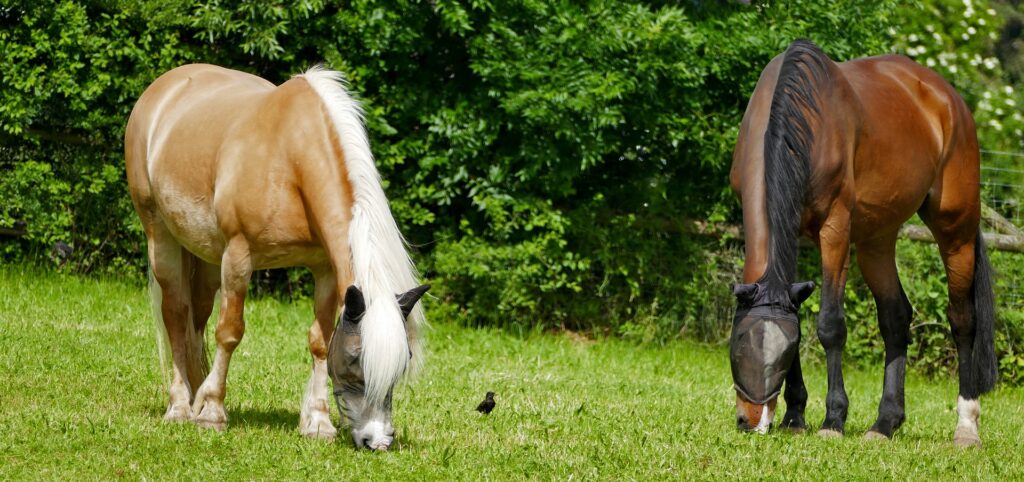
The average horse drinks between 5 to 10 gallons of water per day. It is important to provide clean, fresh water at all times and be aware of increased water necessities during extremely hot days.
Sweat and Sodium Levels
Sodium in your horse’s diet is very important to maintaining proper hydration. Providing a salt block or supplementing with electrolytes can help ensure that your horse is meeting their sodium requirements.
Especially in the extreme summer heat, horse owners should pay attention to the amount of sweat their horse is producing. Anhidrosis, or the inability to sweat normally, can be a common challenge for our equine partners in the summer months, particularly in hot, humid climates. In addition to lack of sweat, signs of Anhidrosis can include increased respiratory rate, elevated temperature, areas of hair loss, or dry, flaky skin. If you notice any of these signs, contact your veterinarian immediately.
Equine Sunburn Tips
Horses with white on their faces or bodies are especially prone to sunburn and should be protected from the harsh UV rays of the sun. Providing shade, covering your horse’s skin with fly sheets or fly masks, and applying sunscreen are all helpful ways to prevent a burn.
Fly masks are now made with extensions to cover the nose and muzzle. There are many different sunscreen products made specifically for horses, but most products approved for human use are also safe for our equine partners. Once again, horses that are particularly prone to sunburn can be kept cool and safe from the sun by staying indoors during the day and being turned out at night.
These are just a few of the important issues to be aware of during the hottest time of the year in Florida and around the country. Remember to keep your horse cool, well-hydrated, and protected from the heat and sun. Contact the veterinarians at Palm Beach Equine Clinic to learn more about precautions that can be taken to keep your horse happy and healthy throughout the summer months.
Today’s competitive sport horses are asked to perform at their absolute best at the most prestigious competitions all over the world. Travel and life at the showgrounds can be extremely stressful for horses. Ulcers can affect any horse, but competitive sport horses with the extra stressors from a life of intensive work and travel are especially prone. Palm Beach Equine Clinic veterinarians want to ensure that your horse remains healthy and ulcer-free. There are many precautions that can be taken to prevent ulcers from developing, but if your horse does develop a problem, Palm Beach Equine Clinic is there to aid in treatment.
Gastric Ulcers and Hindgut Ulcers
There are two different kinds of ulcers – gastric ulcers and hindgut ulcers. The horse can develop one or the other, or both in combination, however gastric ulcers are most common. Gastric ulcers develop in the stomach, which is comprised of two different halves. The lower half of the stomach secretes acid and digestive enzymes to properly digest food. If the acid splashes up to the upper half of the stomach, there is minimal protection and causes painful erosion of the stomach lining.
Increased acidity in the stomach increases the chance of that acid will come in contact with the larger, unprotected portion, resulting in damage to the stomach lining. There are many different factors that can change the environment of the stomach and cause increased acid production, ultimately resulting in ulcers. The most common factors are drastic changes in feeding times or types of feed, undue stress, and corrosive medications.
Ulcer Prevention in Show Horses
For the competitive equine, the stress of traveling and showing, as well as any change in the environment or increased work, can increase the chances of ulcers forming. Abnormal sleep patterns at shows can cause added stress. It is important to ensure that the horse has ample bedding and space to feel comfortable enough to lay down to rest. Joint pain or other physical pain can also cause unnecessary stress to the horse’s system. Joint supplements, routine injections, and alternative therapies such as chiropractic and acupuncture can be used to keep the horse comfortable and stress-free.
Another major cause of gastric ulcers is chronic administration of phenybutazone (bute), banamine, or other nonsteroidal anti-inflammatory drugs (NSAIDs) as these medications can be corrosive to the stomach lining.
Diagnosing Equine Ulcers
Ulcers can be difficult to diagnose as early signs can easily be confused with colic. Many times horses with ulcers show mild, chronic, colic-like symptoms that resolve fairly quickly. Owners and trainers may notice that the horse seems sore after eating, denies feed entirely, or has colic-like symptoms such as upper lip movement, biting at its side, or pawing. If the ulcer is undiagnosed and is given banamine to treat the colic symptoms, ulcers can be exacerbated due to the administration of banamine.
Equine Ulcer Diagnostic Tools
There are several ways to diagnose ulcers. First, if ulcers get severe enough, they can cause the stomach to bleed, and can be tested in a quick blood test to check for a low red blood cell count or anemia. A small amount of dark blood present in the stool can detect bleeding gastic ulcers or the right dorsal colon, but usually it is a microscopic amount and it can be difficult to visualize. A fecal test to test for blood in the stool can be performed but it is not the most specific or reliable method.
The most definitive way to diagnose gastric ulcers is the use of a gastroscope to provide an internal scan. A small camera is inserted down the esophagus and into the stomach, which allows for a clear picture of the separation between the glandular bottom portion and the upper unprotected portion of the stomach. On the gastroscope, ulcers with ranging severity can appear to be a minor red irritation or actual holes, which are depressions of the lining of the stomach. With the gastroscope, you can also visualize the beginning of the small intestine, which is another common area for erosions to occur.
Hindgut ulcers can easily be identified by a non-invasive ultrasound of the colon. With an ultrasound, the veterinarian is able to determine if a specific area of the colon wall is thickened. Thickening of the wall is abnormal and is a primary sign of colonic ulcers. The drugs to treat hind gut ulcers differ from gastric ulcers but the treatment period is still four weeks or more.
Treatment of Equine Ulcers
If ulcers are diagnosed to be present, they are graded as to their location and severity. A treatment plan is determined according to these factors. The gold standard treatment is Omeprazole for four weeks – one tube a day for 28 days. The most common Omeprazole treatment is Gastrogard. Oral supplements, such as calcium, which help to neutralize the stomach acids and act as a buffer to protect the stomach lining, are also sometimes recommended.
If your horse is diagnosed with ulcers, it is important to avoid bute and banamine, if possible. The owner should be careful not to make any significant changes to the horse’s diet. Maintaining a consistent feeding schedule is important to avoid causing any major increases in acid production in the stomach.
Another tip to help keep the pH of the stomach neutral is to add one flake of alfalfa to the horse’s hay per day. It helps to lower the acidity of the stomach. Discuss changes to your horse’s diet with your veterinarian to make sure it will work with your schedule as alfalfa may increase your horse’s energy levels.
Ulcer Prevention
Another way to help prevent ulcers in the future is to prophylactically give Omeprazole a day or two before a stressor. If you know the horse is traveling or going to a show, start administering Omeprazole three to four days prior. Gastric medications can be given every day during the stressor time period, at the show, and then a day or two following the show. It is important to plan ahead and prepare preventative measures that can be very helpful with managing ulcer episodes.
The veterinarians at Palm Beach Equine Clinic are here to help with any concerns for your horse. If you suspect that your horse may have ulcers, or if you want to stay one step ahead and take preventative measures, contact PBEC at 561-793-1599 for more information.
Foot soreness, especially for jumpers, become more noticeable as the winter equestrian season winds down in Florida, according to well-respected veterinarian and farrier Dr. Stephen O’Grady of Palm Beach Equine Clinic.

Foot Soreness Issues Surfacing Toward the End of Winter Competition Season
Dr. O’Grady has been treating horses for 45 years across the country. He also travels extensively all over the world, teaching and training other veterinarians and farriers on therapeutic farriery solutions. It’s obvious to Dr. O’Grady why foot soreness and problems are more common later in the horse show season.
“When horses arrive in Wellington, Florida, in December, foot care starts with bar shoes, pads, pour-ins, etc. as a form of prevention for the busy three months. Perhaps it would be more appropriate to start the competition season by doing a conservative trim, leave horn on the bottom of the foot, and make sure the proper size shoe is selected. The various farrier products may actually add pressure to the structures in the beginning of the season” says Dr. O’Grady.
“When it comes around to March, the structures of the foot have been compromised by the intensity of the competition schedule. The protective farrier products have already been used and there’s nothing more to absorb the shock and energy at the end of the season.”
Preventing Foot Soreness in Competition Horses
Dr. O’Grady adds that it is okay to use different medications and anti-inflammatories as long as the proper dosages and rules are followed as prescribed. But to properly fix foot problems, he has one sure solution.
“Time is the best cure,” Dr. O’Grady says. “The feet are the slowest structures on the horse to recover. There isn’t a magical fix.”
However, Dr. O’Grady has an idea that might help if you cannot give your horse sufficient rest despite the numerous classes and repetitive nature of the show schedule.
As the season wears on, whether it’s WEF or HITS, Dr. O’Grady believes that decreasing the amount of warm up, schooling and lunging makes a world of difference in protecting the hooves.
“But if the feet are sore, the feet are sore,” adds Dr. O’Grady. “There’s no quick fix. It’s all about prevention.”
Snowballing Effects of Foot Soreness
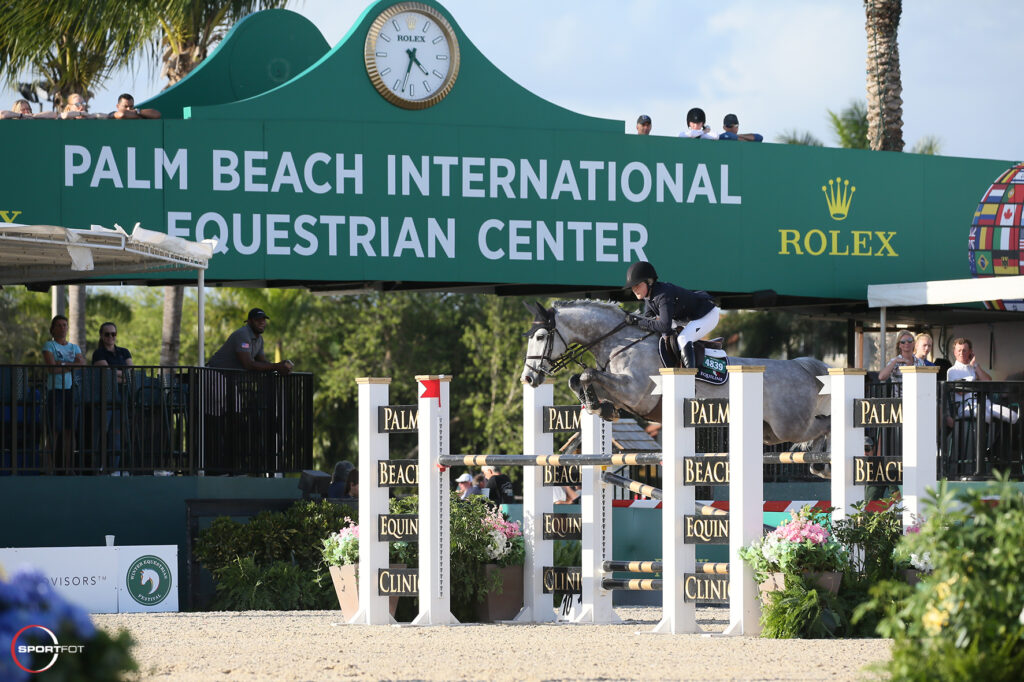
Sore feet can cause numerous problems elsewhere, according to Dr. Robert Brusie, head surgeon at Palm Beach Equine Clinic.
“The horses with sore feet tend to land funny, which can cause strained suspension ligaments or tendons,” says Dr. Brusie. “There also could be sore heels. Sore feet tend to make them short-strided and that could lead to a sore back and or a sore neck.”
Dr. Brusie says one way to notice a horse with sore feet, especially among jumpers, is their reluctance to jump the fences.
“That can be hard on the riders, too,” adds Dr. Brusie.
The foot is the closest to the environment and if you have a sore-footed horse, it could lead to lameness and poor performance, according to Dr. Brusie. Another possibility that could lead to sore feet is being too wet.
“Horses that are to show or play (polo) sometimes get two or three baths a day,” explains Dr. Brusie. Coupled with rings that are sprayed with water to help the footing can lead to problems, he said.
Both Dr. O’Grady and Dr. Brusie believe that taking proper care of your horse’s feet early helps the horses in the long run by eliminating other problems.

For over 30 years, Palm Beach Equine Clinic (PBEC) has offered an unwavering commitment to the care of your horse, whether an Olympic athlete or reliable trail horse. PBEC’s goal is to keep your horse healthy and happy while extending their performance career. PBEC offers innovative veterinary services with the assistance of state-of-the-art diagnostic tools and surgical equipment. They also offer several equine alternative therapies that can optimize your horse’s health and increase the longevity of their career.
Veterinary chiropractic manipulation, acupuncture, and Chinese herbal medicine are three alternatives to standard medical treatments offered at PBEC.
While all of PBEC’s 28 veterinarians are versed in all methodologies of equine medicine, several of the doctors have studied extensively in equine alternative therapies. Dr. Natalia Novoa treats horses with chiropractic manipulation and acupuncture. Dr. Janet Greenfield-Davis focuses specifically in acupuncture treatment and also uses Chinese herbal medicine to bring out the best in her patients.
PBEC’s Dr. Richard Wheeler spoke of how equine alternative medicine can be used to improve your horse’s chance for success and treat many different issues.
Alternative Therapies for Performance Horses
“The line between success and failure is very thin for performance horses, and a lot of these alternative therapies can be very useful to give the horse that little bit more,” Dr. Wheeler explained. “Chiropractic manipulation and acupuncture are two alternative therapies that we offer. They are both conjunctive therapies that can keep horses comfortable, happy and performing well.”


“Both chiropractic manipulation and acupuncture can get the horse moving a little bit better and can help to maintain some minor chronic problems that they may have, therefore avoiding more invasive treatments,” Dr. Wheeler continued. “For neck or back pain, once we diagnose a problem, we may treat it and then follow up with a program of equine alternative therapies. These therapies are used with the aim of keeping the horse supple, and moving with ease, and helping the musculature to work correctly. We work with the trainers to optimize muscle development so that we can fix the problem and keep the horse moving forward and performing at the top level.”
Equine Acupuncture
Dr. Janet Greenfield-Davis is one of the veterinarians at PBEC that is skilled in acupuncture and herbal medicine. Acupuncture is a form of treatment used in both traditional and classical Chinese medicine. It is based on the principle that there are energetic pathways, or channels, throughout the body that influence associated internal organs and structures. Energy from these pathways surface at various points on the body, identified as acupuncture points. Extremely fine gauge needles are inserted at selected points, stimulating these points and thereby activating the body’s natural healing abilities.
“We offer acupuncture, chiropractic and herbal medicine as an alternative or adjunct therapy to your current veterinary protocol,” Dr. Greenfield-Davis explained. “With acupuncture, we stimulate particular points that can relieve pain, increase endorphins, calm, and improve health and body function in horses. These specific points have a high capacity of nerve endings, lymphatic vessels, and blood vessels, as well as hormone stimulation.”
Clinical trials indicate that acupuncture may be an effective adjunct therapy for musculoskeletal problems, such as muscle soreness, back pain, disc problems, osteoarthritis, and degenerative joint disease. Acupuncture may help neurological disorders, such as laryngeal hemiplegia, and facial and radial nerve paralysis. It can help with gastrointestinal disorders, such as diarrhea, gastric ulcers, colic, and impaction. Acupuncture may also help with respiratory diseases, metabolic and endocrine diseases, and other chronic conditions, such as anhidrosis, heaves, asthma, cough, uveitis, and behavioral problems.
Equine alternative therapies such as acupuncture and chiropractic manipulation have gained popularity over the past years. Offering these therapies allows PBEC to treat horses in other ways in addition to their standard practices of equine medicine. Dr. Natalia Novoa is one of the veterinarians at PBEC who offers both chiropractic and acupuncture therapies for clients.
Veterinary Chiropractic Manipulation
“Chiropractic is an excellent complementary modality that can be used for diagnosis, treatment, and prevention of selected neuromusculoskeletal disorders,” Dr. Novoa explained. “The practice of chiropractic focuses on the relationship between structure (primary spinal column) and function (coordinated by the nervous system) to restore it. The goal is to treat soft tissue injuries or articular dysfunction to optimize health through manual therapy and to detect and treat abnormalities and alleviate pain.”


Veterinary chiropractic manipulation is thought to optimize equine health by restoring the normal joint motion, reversing mild pathology, and helping to slow the progression of degenerative joint and spine disease. Over the years, this therapy has become a valuable adjunct for competition horses.
Chiropractic manipulation is also a great treatment option for horses that suffer neck and back pain, nerve damage, poor performance, behavioral problems, muscle spasms, localized or regional joint stiffness, unexplained lameness, gait abnormalities asymmetry/muscle imbalance/atrophy, injuries resulting from falls, trauma (such as slips, getting cast in the stall, or missteps), or poor fitting equipment.
“I identify the restricted movement or subluxations by manipulating and evaluating the joint mobilization. Then I restore the joint motion with an adjustment which is a manual controlled force applied to a specific joint,” Dr. Novoa said of the process.
Complementary Sport Horse Medicine
Chiropractic and acupuncture therapies are complementary treatments for lameness problems and other issue. They are alternative methods and do not replace conventional veterinary medicine or surgery, but can be very useful in maintaining top performance levels in your horse.
“There has been an increase of interest in non-traditional therapy, and PBEC is aware of its great value, so we provide the services to allow our horses to reach maximum performance potential and overall health,” Dr. Novoa concluded.
Palm Beach Equine Clinic provides experience, knowledge, availability, and the very best care for the horses of Wellington. Have them be a part of your team! To find out more, please visit www.EquineClinic.com or call 561-793-1599.
As the official veterinarians of the Winter Equestrian Festival (WEF) and Adequan® Global Dressage Festival (AGDF) in Wellington, FL, Palm Beach Equine Clinic welcomes all veterinarians, local and worldwide, to utilize their services and facilities throughout the winter season.
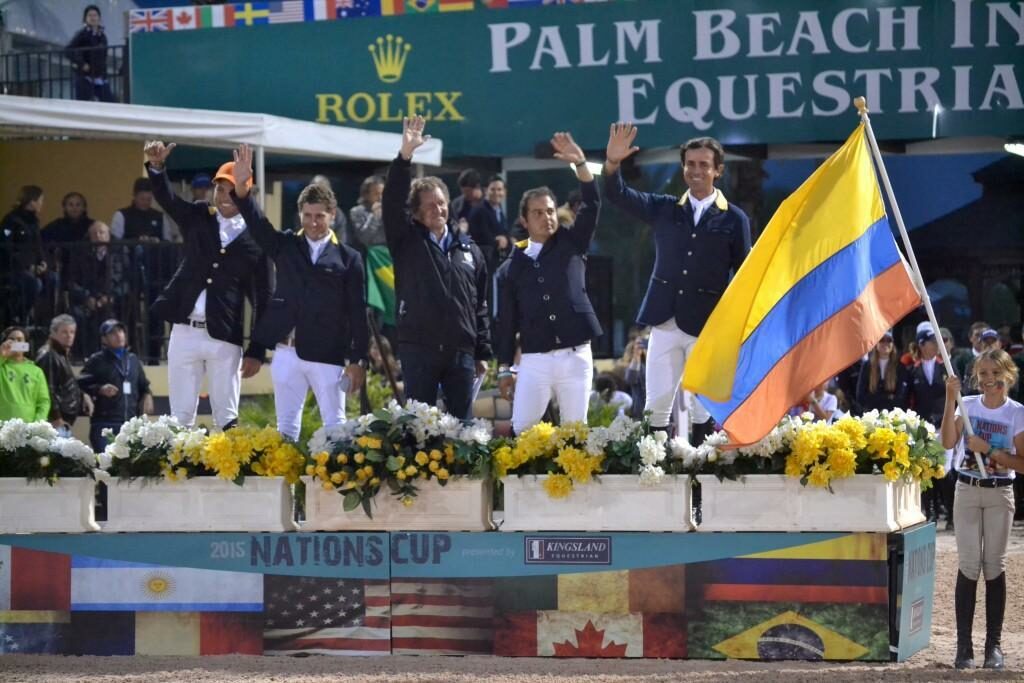
Locating Riding Distance from the Horse Show
Located just down the road from the Palm Beach International Equestrian Center (PBIEC), PBEC offers state-of-the-art surgical tools, highly advanced diagnostic imaging equipment, three board-certified surgeons, one of the top board-certified equine radiologists in the country, and 28 accomplished and knowledgeable veterinarians available to treat clientele of any discipline.
During the winter season, the veterinarians of PBEC donate their time and services to the world-class competitors of the Winter Equestrian Festival. Week eight of the 12-week WEF circuit is currently underway with CSIO competition, and PBEC welcomes the international team veterinarians to make use of their services as horses and riders compete in the prestigious Nations’ Cup classes.
Horse and rider teams from all around the world will be competing in the esteemed senior Nations’ Cup on Friday night, March 4, beginning at 7 p.m. Hollow Creek Farm will be hosting the Children’s, Junior and Young Rider FEI Nations’ Cup team events on Saturday evening, March 5, 2016. The teams have flown from over ten different countries throughout South America, North America, and abroad to compete this week.
Proud to be Part of Prestigious Competiton
For PBEC President, Dr. Scott Swerdlin, the Nations’ Cup events provide some of the most exciting competition of the circuit and he is proud to have his veterinarians well-represented.
“Those two nights that we have the Nations’ Cup classes, everyone is so competitive and proud of their country and proud of the horses in their country,” said Dr. Swerdlin. “Nations’ Cup week is one of the highlights of WEF and we really appreciate having the opportunity to be supportive of all of the teams. For us, it is just a privilege to be a part of such a special competition. We enjoy working with the different veterinarians and they are always welcome to come to PBEC if they are traveling with a team. Our motto is ‘Make us a part of your team,’ and we hope that visiting doctors will take advantage of the world-class services that we have to offer.”
All-Inclusive Equine Hospital, Imaging and Emergency Services
PBEC’s Dr. Richard Wheeler spoke of the support that the clinic is able to provide to the teams as they compete throughout the week in Nations’ Cup classes.
“Being a full-service facility, we are proud to provide support to the international teams,” said Dr. Wheeler. “It is great to see the international horse community come together and it is fun for us to build relationships with vets from all over the world. We often have vets come to visit us and spend time in our hospital, and likewise, we visit them in their facilities.

“We are here to support them,” Dr. Wheeler continued. “In an emergency situation, we are here to provide hospitalization and ambulatory services. We offer advanced imaging services such as MRI and Nuclear Scintigraphy, we have a fantastic team of internal medicine specialists that includes three board-certified surgeons, and we have one of very few board certified equine radiologists in the world.”

Dr. Wheeler added, “PBEC always has a veterinarian on the show grounds any time competition is going on. We also have a new Annex office on the show grounds this year so that the doctors can quickly and safely treat horses in a clean environment. The hospital is then ready for emergencies 24/7, with specialists, equipment, and personnel ready to handle any situation.”
Surgical Services Available When Needed
PBEC Staff Surgeon Dr. Jorge Gomez serves as the team veterinarian for Colombia and Venezuela. Dr. Gomez finds his partnership with PBEC very important throughout the season.
Dr. Gomez explained his responsibilities as team vet, stating, “I am in charge of the health and soundness of the horses in the team. Before the events, and once the horses for the team are chosen, I look at all of the team horses individually to make sure the horses are in good condition to compete. We check all the health papers and passports to make sure they are up to date. During the competition days, I perform horse inspections before and after every class. In conjunction with the grooms, we also make sure that the horses are in normal condition with no modifications of their normal behavior.”
If there are any concerns of a horse’s well-being, Dr. Gomez and all of the team veterinarians have the diagnostic services of PBEC at their fingertips. Along with the advanced imaging capabilities and emergency surgical services, teams can make use of PBEC’s niche offerings, such as chiropractic care or acupuncture as well.
Palm Beach Equine Clinic provides experience, knowledge, availability, and the very best care for the horses of Wellington. Have them be a part of your team!
Palm Beach Equine Clinic (PBEC) is one of the few equine hospitals in the country to have a full-time radiologist on-site during season. With the addition of Dr. Sarah Puchalski to their staff, as well as the installation of the most state-of-the-art imaging equipment, Palm Beach Equine Clinic has become a leader in diagnostic sport horse imaging.
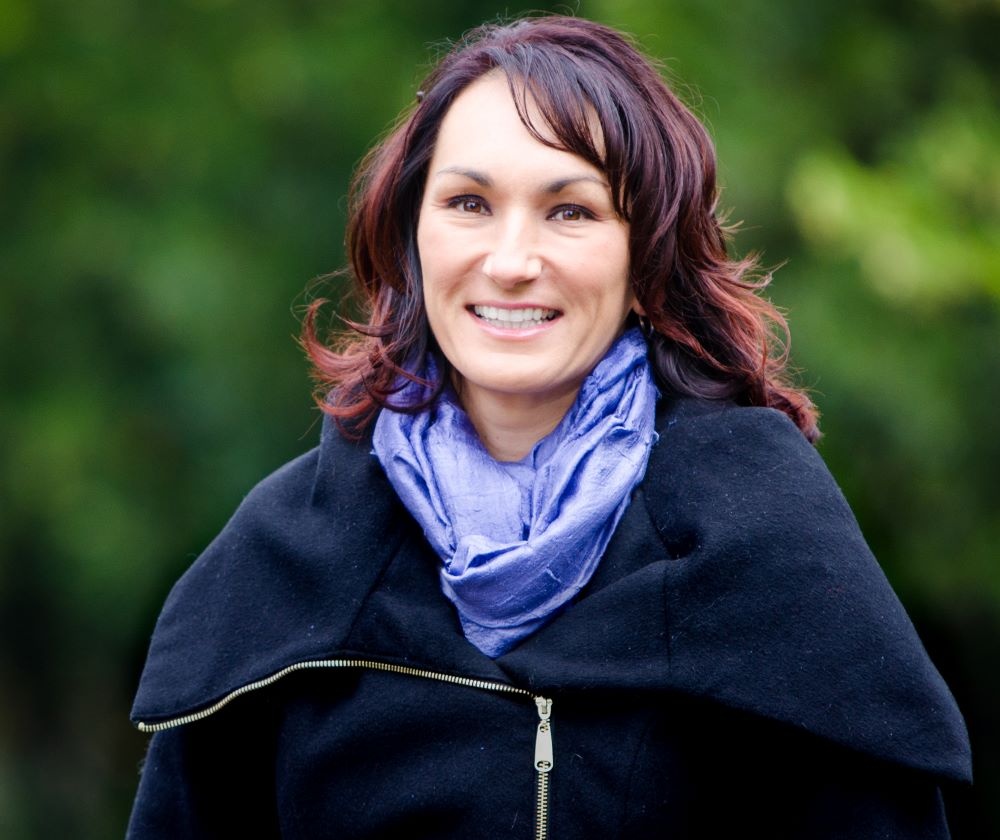
Dr. Puchalski is one of very few board-certified equine Radiologists in the country and one of the most high profile of those in the world. Early in her career, Dr. Puchalski earned the respect of the best in the industry and strives to continue to contribute advances for equine sports medicine and diagnostic imaging.
Dr. Puchalski’s job takes extensive training and a high level of specialization to properly review diagnostic imaging, including MRIs and Nuclear Scintigraphy bone scans to produce written reports for referring veterinarians. In addition to her full-time position with Palm Beach Equine Clinic, she reads cases from all over the world on a daily basis. Many veterinarians and owners request to consult with her for a second opinion.
Potential for Growth
After eight years working as a faculty member at the University of California Davis, Dr. Puchalski decided to take a job with Palm Beach Equine Clinic in December 2013. She had been consulting on Palm Beach Equine Clinic cases for several years prior to the move and felt it was a natural progression. Palm Beach Equine Clinic made huge advances to their in-house imaging technology under her direction.
Almost 30 years ago, Palm Beach Equine Clinic bought the first ultrasound for equine practice in South Florida. Twenty-five years ago, Palm Beach Equine Clinic installed the first gamma ray camera to perform bone scans (Nuclear Scintigraphy). Twenty years ago Palm Beach Equine Clinic developed Computed Radiography (CR) for horses. Currently, Palm Beach Equine Clinic has the most advanced state-of-the-art surgical and diagnostic imaging equipment available. Onsite, they have a Hallmarq standing equine MRI unit, MiE gamma ray camera, Digital Radiography, Video Endoscopy, and a bevy of additional diagnostic equipment.
“ Palm Beach Equine Clinic has a great case population and great equipment, which is a huge bonus for someone doing what I do,” Dr. Puchalski stated. “The equipment is exceptional, the technical staff is excellent, and the case population of the region is obviously amazing.”
Palm Beach Equine Clinic is dedicated to providing exceptional veterinary service for the horse, and Dr. Puchalski proudly supports that mission through her work. She diagnoses issues from complicated images that assist veterinarians in the proper, effective treatment plan. She is able to provide a second opinion on routine diagnostic techniques such as radiographs and ultrasounds. She is also able to provide diagnostic reports for pre-purchase examinations based on the imaging submitted.
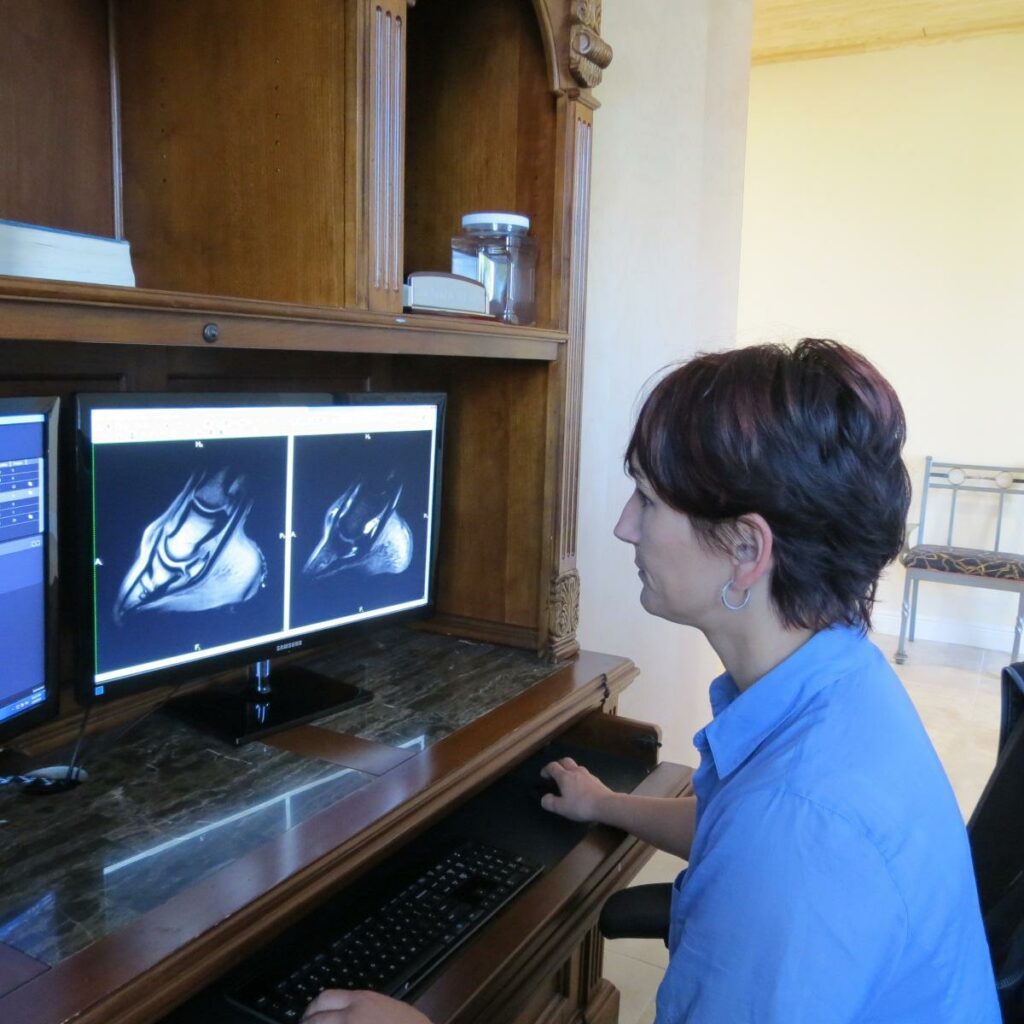
For Dr. Puchalski, the potential for future growth in diagnostic imaging services at Palm Beach Equine Clinic is huge.
“There are new technologies coming into the market for imaging all of the time and Palm Beach Equine Clinic will remain abreast of those advances,” Dr. Puchalski said. “Going forward, we are looking to acquire new equipment, and I think it is fair to say that the hospital will see an increasing role with different kinds of cases. There are a lot of changes in the market that occur very quickly, so we are always trying to figure out the best thing for this practice.”
Finding Time to Ride
In addition to working with PBEC locally and assisting veterinarians around the world, Dr. Puchalski competes her Oldenburg mare, Lucia de Luxe, in the Medium and High Amateur-Owner Jumpers.

Dr. Puchalski splits her time throughout the year between her homes in California and Florida. She is based in Wellington for about five months, and enjoys competing at the Winter Equestrian Festival, for which PBEC serves as the official veterinarians.
Although her horse is currently injured, Dr. Puchalski normally rides every day and enjoys the flexibility of her job that supports her riding schedule.
“One of the best parts of what I do is the flexible schedule,” she admitted. “I try to ride every day and fit everything else around it. I can really do my job from anywhere. It can be completely web-based, which I love.”
“First thing in the morning, I check into the clinic and check on the imaging cases for the day,” Dr. Puchalski detailed. “I usually read some MRI and Nuclear Scintigraphy cases and then go ride mid-morning. Then I come back and read cases for my other clients. PBEC is a big chunk of my work, but a lot of my cases also come from global clients; I have clients all over the world.”
From a Small Town to Big Dreams
Dr. Puchalski grew up on a small-town acreage in British Columbia and started riding at a very young age. She got her first pony when she was four years old and continued riding at a three-day eventing barn next door to her home. Early on, Dr. Puchalski knew that she wanted to be a veterinarian. Dr. Puchalski graduated with a BS in Biology from Simon Fraser University in British Columbia, and completed her Doctorate of Veterinary Medicine from the University of Saskatchewan in Saskatoon. She interned in Field Service and Sports Medicine at New Bolton Center at the University of Pennsylvania, and completed her residency in Radiology at UC Davis in 2005.
During her internship at the New Bolton Center, Dr. Puchalski decided to pursue a career as a Radiologist thanks in part to one of her valued mentors, Virginia Reef, at the University of Pennsylvania.
“Dr. Reef was a huge influence on my career direction at that stage,” Dr. Puchalski noted. “Ginny was an influence in me becoming a radiologist, and then as a radiologist, I was mentored by Tim O’Brien at UC Davis – he is a founding father of equine radiology.”
Continuing to Have an Influence
Prior to joining PBEC in 2013, Dr. Puchalski spent eight years on the faculty of UC Davis providing research instruction and clinical service. Dr. Puchalski has published many scientific articles in diagnostic imaging and equine injuries which was a huge component of her early career.
“Once you have published research, the spinoff is then to publish in textbooks and other literature, so I have done a number of chapters for major lameness and diagnostic imaging textbooks as well,” Dr. Puchalski explained. “I have published more than 50 scientific articles and performed over 100 presentations all over the world on lameness diagnosis and diagnostic imaging in sport horses. I am currently trying really hard to still publish study results and be involved with universities, but also have a very busy private practice caseload.”
Outside of work and horses, Dr. Puchalski enjoys the challenges of Crossfit. In addition to her time spent in Florida and California, she also spends several weeks every summer working and showing at Spruce Meadows in Calgary, Alberta, Canada.
Dr. Puchalski is an integral part of the team at Palm Beach Equine Clinic and will continue to serve PBEC’s clientele as diagnostic imaging advances into the future.
Palm Beach Equine Clinic provides experience, knowledge, availability, and the very best care for the horses of Wellington. Have them be a part of your team! To find out more, please visit www.EquineClinic.com or call 561-793-1599. “Like” them on Facebook to follow along on what happens in Wellington and more, and get news from their Twitter!
More About Dr. Sarah Puchalski
Dr. Puchalski is a Diplomate of the American College of Veterinary Radiology whose specialty includes the interpretation of radiographs in addition to other diagnostic imaging techniques.
Dr. Puchalski is from Davis, CA, where she was an associate professor at the University of California in their Department of Surgical and Radiological Sciences. In 1995, she received her BSc in biology from Simon Fraser University in British Columbia, and in 1999 earned her Doctor of Veterinary Medicine from the University of Saskatchewan in Saskatoon, where she received the ACVS Outstanding Large Animal Surgery Student award that same year. Dr. Puchalski interned in Field Service and Sports Medicine at New Bolton Center at the University of Pennsylvania in 2001, and completed her residency in radiology at UC Davis in 2005.
Dr. Puchalski has devoted her career to teaching and improving equine health through the development and refinement of diagnostic techniques. In 2011 she contributed to two books on the topic of equine lameness. Her recent contributions include chapters in Diagnosis and Management of Lameness in the Horse edited by Ross and Dyson, as well as in Veterinary Computed Tomography and the Clinical Veterinary Advisor: The Horse, Equine Colic and Veterinary Clinics of North America. She also has contributed close to 50 scientific articles concerning the diagnosis of equine lameness to many periodic journals, including Veterinary Radiology & Ultrasound: the official journal of the American College of Veterinary Radiology and the International Veterinary Radiology Association; Veterinary Pathology; Equine Veterinary Journal; the American Journal of Veterinary Research; Equine Veterinary Education; Journal of the American Veterinary Medical Association; and Journal of Veterinary Internal Medicine.
This fall, the United States Equestrian Federation (USEF) unveiled its latest health rule requiring all horses entering a Federation-licensed competition be accompanied by documentation of Equine Influenza Virus (flu) and Equine Herpes Virus (rhinopneumonitis) vaccinations within six months of being stabled at the show. Now approaching a month of enforcement during the 2016 winter show season, the new vaccination requirements enacted by the USEF gave structure to requirements that were previously being developed and enforced on a show-by-show basis.
After Florida’s Equine Herpes (EHV) scare in February of 2013, horse show facilities began adopting vaccination requirements of their own, usually requiring EHV-1 and EHV-4 vaccines within 90 to 120 days of a horse’s arrival to the grounds.
Now, USEF specifically requires all licensed competitions comply with the same set of requirements while not increasing the workload for competition management. The six-month timeline also matches the operating procedures of international shows overseen by the FEI as well.
According to Palm Beach Equine Clinic’s own Dr. Richard Wheeler, the rule change simply makes sense.
“Most people regularly vaccinate their horses every six months anyway, so this rule should not present a disruption to current practices,” he said. “After the 2013 scare, competitions recognized the potential of closure due to infectious disease and started creating requirements which became inconsistent between shows.”
Whether directly or indirectly affected by rule change itself, an increase in awareness regarding equine infectious disease in recent years had minimized outbreaks, according to Dr. Wheeler.
“A good job is being done so far to keep a big problem away,” he added.
While efforts by the USEF, veterinarians, and horse owners alike have proved successful in keeping horses safe and healthy, Dr. Wheeler was quick to remind the equine community to not get complacent. He stresses the continuation of education and awareness.
“An increase in bio-security is the most significant benefit we’ve had as a result of these requirements,” he said. “This is the most protective measure that we have taken on as a community, and people are now cognizant of how disruptive bringing a sick horse to a show can be. We see people getting vets involved quickly and shows doing a good job of providing isolation. What’s been done in the past few years is a positive thing, but it’s important that we don’t let our guard down because we haven’t had an outbreak in a few years.”


In addition to abiding by the USEF’s six-month rule, Dr. Wheeler also suggests the individuals responsible for caring for horses continue their efforts past the gates of the facility.
“Horse shows are often condensed places and limiting the exposure of horses is difficult,” he said. “It’s important that we stay really aware, take temperatures regularly, identify sick horses, and isolate them immediately. It’s all key to prevent outbreaks.”
Thanks to regulations, always improving technology, educated veterinarians, and diligent horsemen and women, the equine community is becoming more guarded against infectious disease than ever before.
To read more about the USEF vaccination requirement, click here. The experts at Palm Beach Equine Clinic stand ready to answer any questions horse owners may have about vaccinations and the requirements needed for equestrian competitions.
